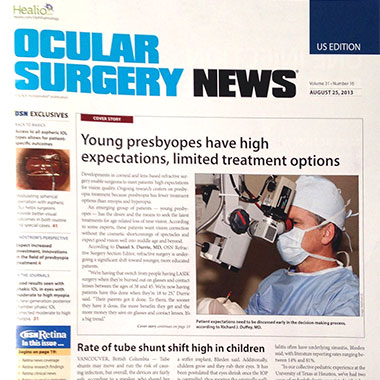Dr. Richard Duffey Featured in Ocular Surgery News About Presbyopes Expectations

Developments in corneal and lens-based refractive surgery enable surgeons to meet patients high expectation for vision quality. Ongoing research centers on presbyopia treatment because presbyopia has fewer treatment options than myopia and hyperopia. An emerging group of patients – young presbyopes – has the desire and the means to seek the latest treatments for ag-related loss of near vision. According to some experts, these patients want vision correction without the cosmetic shortcomings of spectacles and expect good vision well into middle age and beyond.
Premier Medical’s Richard J. Duffey, MD, emphasized educating patients about potential outcomes and complications.
“It’s all about expectation. You’ve got to have those discussions on the front end,” Duffey said. “They all carry with them some sort of baggage, the accommodating lenses. They tend to change long-term. You can get some decent accommodation early on, but they tend to change. You can get some decent accommodation early on, but they tend to have less accommodation later, and the patient is happy early, but not happy long term.”
Amid the ongoing surge in presbyopia, only 10% of people in the United States know they should discuss presbyopia-related changes in vision with an eye care professional, and only 18% of presbyopes are aware of multifocal contact lenses as a treatment option. According to the U.S. Trends in Refractive Surgery: 2012 International Society of Refractive Surgery survey presented by Dr. Duffey in 2012, 71% of respondents had implanted presbyopic IOLs. The results also showed that 41% favored monovision as the preferred surgical method for pre-cataract presbyopia, 30% favored modified monovision, 15% preferred a multifocal IOL and 4% favored accommodating IOL.
If you have a subscription to Ocular Surgery News more on this story can be found here.
